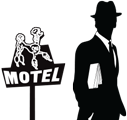Filthy Luker, artist
if you’re always trying to paint your masterpiece you’ll never do it, you just have to keep creating and creating ...
Don’t be alarmed if you happen to be walking through Surfers Paradise and catch a glimpse of a gigantic octopus engulfing the Soul building or giant writhing tentacles emerging from the Islander Resort, no we’re not being taking over by giant sea creatures, that’s the work of Luke Egan aka Filthy Luker and Pete Hamilton aka Pedro Estrellas. Luke and Pete designed and created the inflatable installations to signal the first partnership between Sand Safari and Swell Sculpture Festival. We had a chat with Luke about street art, sea anemones and anthropomorphism.
Your art tends to be larger than life with giant squids attacking cities, diversions around huge banana skins and trees turned into characters. What inspires you?
The wackier stuff, I love to get people to do the double take. It’s fun to make the world a more bizarre place. It’s one thing to paint a surreal picture but to actually put an out-of-place object into the world is another level of experience, and with the instant effect of inflatables, it really weirds people out to transform their everyday environment in the blink of an eye.
You’ve been described as a painter who is attacking his audience. How would you describe your style of art?
That quote was from a Russian exhibition and it just tickled me that they would say that because I’m obviously not a painter and I’m not attacking anyone. I work alongside a really talented designer called Pete Hamilton aka Pedro Estrellas. We both have silly street names because in street art you don’t get taken seriously without one, but I would call what we do as interventionist. He’s really into geometrics, beautiful forms and nature where as I am more into the figurative stuff and just being a bit weird so we work together really well.
How did you get into creating inflatable art installations?
Well this comes down to Pete, he had an accident with a hairdryer and a pair of trousers in his workshop. Not really, he was mucking around with a crazy inventor who was making lots of bicycle-powered party stuff for the emerging dance scene of the early 1990s. Pete found an old fan and started making small inflatables to hang up at parties. He realised how exciting the medium was and was soon flying around the world with a backpack full of the spiky inflatables he made. Two years into that I happened to be sharing a workshop with him and he invited me to join him and within a month I was making stuff too.
Some of your other works have included a grumpy discarded TV and a snaggle-toothed rubbish bin. Is there an underlying environmental theme to your creations?
I’ve got a few different avenues of my art. There’s the decorative stuff, which you can see in Surfers Paradise with the jellyfish, which is often inspired by natural forms, then there’s the more interventionist stuff with the giant eyeballs and then there’s the more graffiti-style stuff that I do, which is basically the anthropomorphism of objects by sticking eyes on stuff. I used to live in a fairly run-down part of Bristol and there’s a lot of rubbish and discarded objects around so instead of getting angry or depressed about them I bring them to life, give them characters, a story. I’m not really into vandalism but I see discarded objects and mundane street furniture as fair game. If you can make a pile of shit look like art then I think it’s a good thing. Many contemporary artists do this the other way round!
What do you hope to achieve through your art?
Street art is really about reaching a wider audience. I like to turn a few heads and make people smile.
You’ve had work exhibited all over the world, can you share with us some career highlights?
The banana skin was a fun one because it was one of the times we broke through red tape. In England everyone is really hard on health and safety, as they are here, so this was intended as a bit of a joke, like “watch out, banana skin!” I was cruising the city with this giant banana skin in the back of my van, looking for somewhere to put it and found this perfect space where some road works were going on. I approached the workmen, they had to ask their boss and he just giggled and gave us the go ahead. You don’t get to do that kind of thing very often so that was really cool. I also love travelling to random places around the world and seeing things that people who live there never get to see, like the tops of roofs.
What are some of the challenges creating large-scale works?
The biggest challenge is the weather. Things can get chaotic and you need to keep your wits about you. The great thing about inflatables is that they are instantly up and they can be instantly taken down as well.
What’s the craziest thing you’ve done in the name of art?
This kind of links to the last question in that you can be holding a 10-metre sea anemone and a big gust of wind comes along, I call it extreme art.
What’s the best part about being an artist?
Getting to travel and come to places like this, meeting enthusiastic people who encourage and work on your behalf to make great stuff happen. I have to thank the Swell Sculpture Festival team for this one, they have been wonderful champions of our work.
You’re on the panel of judges for the sand sculpting competition as part of Sand Safari, what are you looking for in the winning piece?
I am looking for concept, execution, originality and impossibility! The contestants are given three-tonnes of sand and I want to see every grain used.
Brisbane-based street artist Anthony Lister was recently found guilty of a wilful damage graffiti charge over his paintings on four sites around Brisbane. What’s your view on street art?
Street art is part of our everyday lives and psyche, more so than the most famous fine art pieces. You go to a gallery and the average time spent looking at a painting is 10-seconds, or you will look at a Turner reproduced at 10 centimetres square in a book, whereas if you have a nice piece of art on the wall you’ll see it every day, it’s part of your life. If you are bringing art to people then that’s got to be a good thing. I don’t believe in painting over lovely buildings and things but there are so many blank walls, I’d rather have art on there. The role of street art is really important and being seen in public is important to encourage the artist, so to pass all graffiti off as vandalism is unfair.
Do you have any words to live by?
Elvis said it best when he said a little less conversation a little more action but to go further than that, as an artist, if you’re always trying to paint your masterpiece you’ll never do it, you just have to keep creating and creating. To paraphrase Pablo Picasso, inspiration is there but it must find you working. I think people get crippled by fear that they have to make the next best piece but that’s not the right attitude. The right attitude is to keep creating and good stuff will come.


